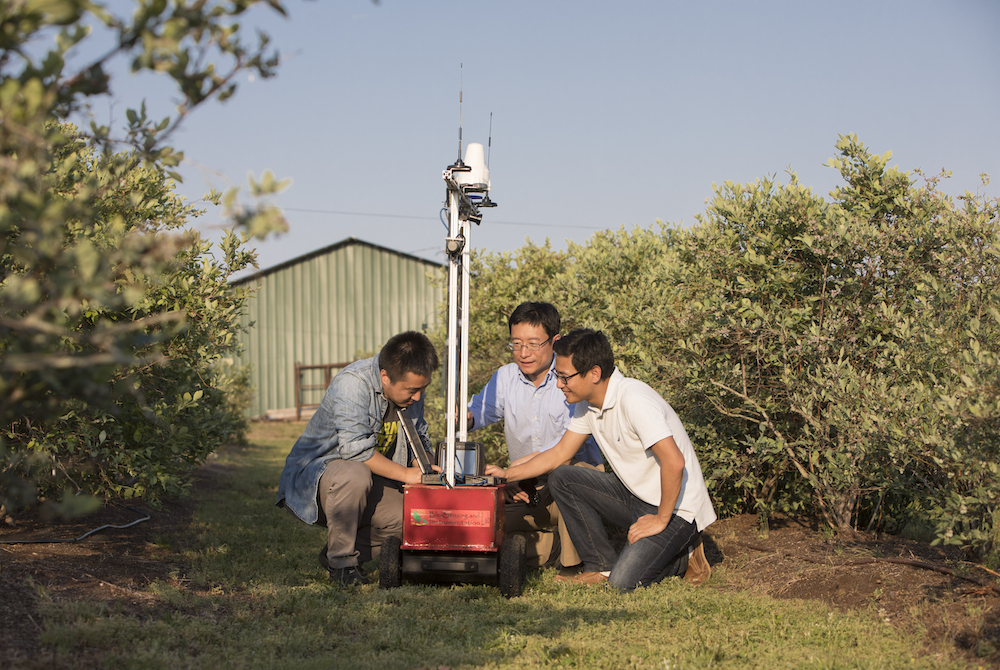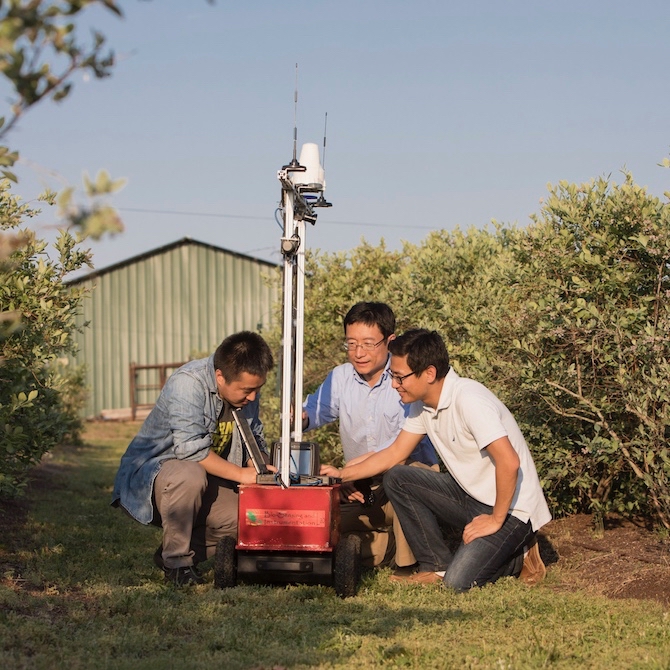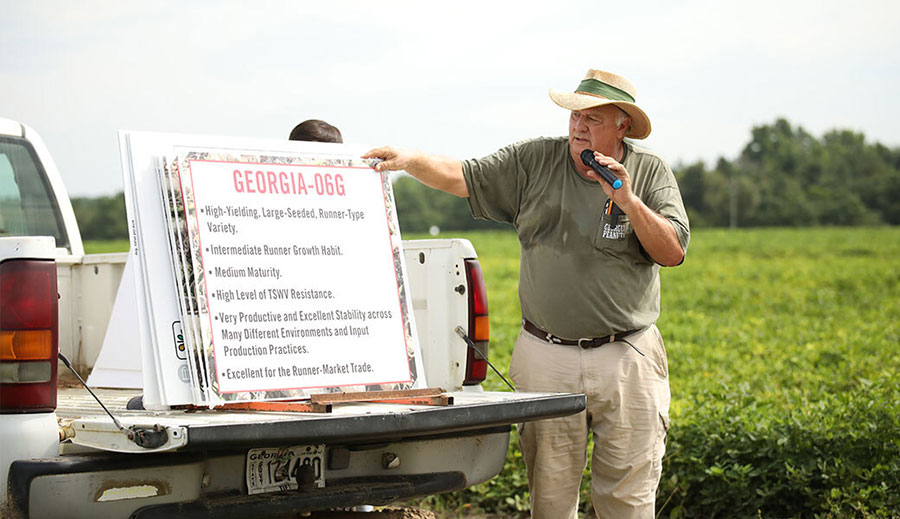Automated data collection and analysis pipelines are changing the way humans generate and use information. At the University of Georgia, researchers harness the power of advanced sensing, robotics and big-data analytics to change agriculture.
From streamlining the development of new crop varieties to improving cultural practices to enhance soil health, advanced sensing and robotics are key to developing more productive, sustainable agricultural systems.
About 50 UGA researchers gathered for the inaugural Phenomics and Plant Robotics Center (PPRC) Symposium on March 9 to discuss how advances in these areas are changing the world of agriculture.
A phenotype is a physical or biochemical trait that is controlled by a single gene or a set of genes inside a plant or animal’s total genetic code, and an animal or plant’s phenome is the collection of all of the animal or plant’s individual physical and biochemical traits. Phenomics is the study of these collections of traits across a population, and it’s the subject of the new PPRC at UGA.
Housed in the university’s Office of Research, the center is led by engineering Professor Charlie Li. It was founded in 2018 and includes 35 UGA faculty members from 17 UGA units and four colleges, including the UGA College of Agricultural and Environmental Sciences.
“Our center will promote convergent research between plant breeding, genomics and biomass characterization; engineering; and computational sciences to propel UGA into a global leadership position in phenomics and plant robotics,” Li said. “The University of Georgia is exceptionally positioned to take the lead in this area because of its burgeoning informatics initiative, the growing strength of our College of Engineering and our world-class plant science research.”
The center’s founding members include Li; Harald Scherm, CAES professor and plant pathology department head; Scott Jackson, Georgia Research Alliance Eminent Scholar, CAES crop and soil sciences professor, and director of the UGA Center for Applied Genetic Technologies; Alexander Bucksch, Franklin College of Arts and Sciences assistant professor of plant biology; and Ping Ma, Franklin College professor of statistics specializing in bioinformatics, functional data analysis and geophysics.
The PRCC’s goal is to foster the development of high-throughput phenotyping technologies using robotics and big-data analytics to aid in breeding more sustainable, productive crops by identifying individual plants, amongst the thousands in crop field, with traits that breeders want to emphasize in new varieties. For instance, a robot could use computer vision and deep-learning neural networks to find plants with ideal root structures or ideal growth habits.
The center supports research into the development of these types of systems by providing continuing education for faculty through an annual symposium and a series of regular brown-bag seminars on robotics and phenomics. The center will also support partnerships with universities and research centers outside UGA, offer development workshops, help UGA administrators pinpoint specific research needs and recruit faculty to fill those needs.
The inaugural symposium included presentations from Penn State University Distinguished Professor John Lynch, a plant physiologist, and Regents’ Professor of Crop and Soil Sciences and Genetics Andrew Paterson, a UGA plant geneticist and breeder.
Lynch, a world-renowned root physiologist, currently uses phenotyping robots to select corn plants with root systems that maximize their uptake of phosphorus from the soil, which could lead farmers to apply less fertilizer to their land but still produce healthy corn crops.
Geneticists often look for one favorable trait — high yield, for instance — and then spend years searching for the genes that control that one trait so that it can be bred into future generations of the crop, Lynch told the crowd gathered at the symposium. He argued that the search for genes that control favorable traits is invaluably important, but it sometimes means that researchers can’t see the forest for the trees. Assessing all of the traits in a successful adult plant allows breeders to see how multiple traits work together to keep a plant healthy and productive. That’s where robotic phenotyping and the study of phenomics is invaluable.
Paterson presented his collaborative work with Li. They use crop-imaging robots at the CAES Iron Horse Farm to identify crops with traits he would like in future varieties of staple crops.
“One of the reasons that breeding proceeds slowly is because phenotyping is laborious,” Paterson said. “In my lab, I’ve been known to have phenotyping parties where we take the whole lab out to the field, and we measure and count and weigh and harvest. It might go on for days or weeks. We spend a lot of time measuring plants and measuring plant traits.”
Phenotyping robots that can gather and analyze information about plants would greatly speed up the selection process involved in breeding better-adapted plants into new crop varieties.
Some of these technologies are already used to spot diseased plants or plants under drought or heat stress. Farmers use this information to pinpoint where irrigation, pesticide and fertilizer applications are necessary in an effort to minimize the impact on water and soil resources and to reduce costs.
As the center produces new technologies to breed more sustainable, resilient crops and to help farmers practice more precise agriculture, robotics will become a key part of meeting the world’s growing demand for food while protecting the natural environment.
For more information about the center and its work, visit pprc.uga.edu.








